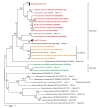Neurotropic Astroviruses in Animals
- PMID: 34201545
- PMCID: PMC8310007
- DOI: 10.3390/v13071201
Neurotropic Astroviruses in Animals
Abstract
Astrovirus infections are among the main causes of diarrhea in children, but their significance for animal health has remained underestimated and largely unknown. This is changing due to the increasing amount of newly identified neurotropic astroviruses in cases of nonsuppurative encephalitis and neurological disease in humans, pigs, ruminant species and minks. Neurological cases in ruminants and humans usually occur sporadically and as isolated cases. This contrasts with the situation in pigs and minks, in which diseases associated with neurotropic astroviruses are endemic and occur on the herd level. Affected animals show neurological signs such as mild ataxia to tetraplegia, loss of orientation or trembling, and the outcome is often fatal. Non-suppurative inflammation with perivascular cuffing, gliosis and neuronal necrosis are typical histological lesions of astrovirus encephalitis. Since astroviruses primarily target the gastrointestinal tract, it is assumed that they infect the brain through the circulatory system or retrograde following the nerves. The phylogenetic analysis of neurotropic astroviruses has revealed that they are genetically closely related, suggesting the presence of viral determinants for tissue tropism and neuroinvasion. In this review, we summarize the current knowledge on neurotropic astrovirus infections in animals and propose future research activities.
Keywords: astrovirus; neurological disease; non-suppurative encephalitis.
Conflict of interest statement
The authors declare no conflict of interest.
Figures



Similar articles
-
Indication of Cross-Species Transmission of Astrovirus Associated with Encephalitis in Sheep and Cattle.Emerg Infect Dis. 2017 Sep;23(9):1604-1608. doi: 10.3201/eid2309.170168. Emerg Infect Dis. 2017. PMID: 28820378 Free PMC article.
-
Detection of Astrovirus in a Cow with Neurological Signs by Nanopore Technology, Italy.Viruses. 2020 May 11;12(5):530. doi: 10.3390/v12050530. Viruses. 2020. PMID: 32403368 Free PMC article.
-
Neurologic Clinical Signs in Cattle With Astrovirus-Associated Encephalitis.J Vet Intern Med. 2017 Jul;31(4):1209-1214. doi: 10.1111/jvim.14728. Epub 2017 May 22. J Vet Intern Med. 2017. PMID: 28544318 Free PMC article.
-
Nonsuppurative (Aseptic) Meningoencephalomyelitis Associated with Neurovirulent Astrovirus Infections in Humans and Animals.Clin Microbiol Rev. 2018 Aug 29;31(4):e00040-18. doi: 10.1128/CMR.00040-18. Print 2018 Oct. Clin Microbiol Rev. 2018. PMID: 30158300 Free PMC article. Review.
-
Astrovirus infections in humans and animals - molecular biology, genetic diversity, and interspecies transmissions.Infect Genet Evol. 2011 Oct;11(7):1529-44. doi: 10.1016/j.meegid.2011.07.024. Epub 2011 Aug 5. Infect Genet Evol. 2011. PMID: 21843659 Free PMC article. Review.
Cited by
-
Discovery of three novel neutralizing antibody epitopes on the human astrovirus capsid spike and mechanistic insights into virus neutralization.J Virol. 2025 Feb 25;99(2):e0161924. doi: 10.1128/jvi.01619-24. Epub 2025 Jan 23. J Virol. 2025. PMID: 39846739 Free PMC article.
-
Assessing the Prevalence of Astroviruses in Water Environments: A Systematic Review and Meta-analysis.ACS ES T Water. 2023 Nov 15;3(12):3782-3789. doi: 10.1021/acsestwater.3c00415. eCollection 2023 Dec 8. ACS ES T Water. 2023. PMID: 38094915 Free PMC article. Review.
-
Mouse and human immune responses share neutralization epitopes of HAstV-VA1.J Virol. 2024 Jul 23;98(7):e0097124. doi: 10.1128/jvi.00971-24. Epub 2024 Jun 25. J Virol. 2024. PMID: 38916399 Free PMC article.
-
Discovery of three novel neutralizing antibody epitopes on the human astrovirus capsid spike and mechanistic insights into virus neutralization.bioRxiv [Preprint]. 2024 Sep 14:2024.09.14.613010. doi: 10.1101/2024.09.14.613010. bioRxiv. 2024. Update in: J Virol. 2025 Feb 25;99(2):e0161924. doi: 10.1128/jvi.01619-24. PMID: 39314284 Free PMC article. Updated. Preprint.
-
Mamastrovirus species are shaped by recombination and can be reliably distinguished in ORF1b genome region.Virus Evol. 2025 Jan 31;11(1):veaf006. doi: 10.1093/ve/veaf006. eCollection 2025. Virus Evol. 2025. PMID: 39989717 Free PMC article.
References
Publication types
MeSH terms
LinkOut - more resources
Full Text Sources
Medical

